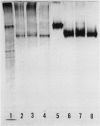Abstract
Maize (Zea mays L.) β-glucosidase (β-d-glucoside glucohydrolase, EC 3.2.1.21) was extracted from the coleoptiles of 5- to 6-day-old maize seedlings with 50 millimolar sodium acetate, pH 5.0. The pH of the extract was adjusted to 4.6, and most of the contaminating proteins were cryoprecipitated at 0°C for 24 hours. The pH 4.6 supernatant from cryoprecipitation was further fractionated by chromatography on an Accell CM column using a 4.8 to 6.8 pH gradient of 50 millimolar sodium acetate, which yielded the enzyme in two homogeneous, chromatographically different fractions. Purified enzyme was characterized with respect to subunit molecular weight, isoelectric point, amino acid composition, NH2-terminal amino acid sequence, pH and temperature optima, thermostability, and activity and stability in the presence of selected reducing agents, metal ions, and alkylating agents. The purified enzyme has an estimated subunit molecular mass of 60 kilodaltons, isoelectric point at pH 5.2, and pH and temperature optima at 5.8 and 50°C, respectively. The amino acid composition data indicate that the enzyme is rich in Glx and Asx, the sum of which approaches 25%. The sequence of the first 20 amino acids in the N-terminal region was H2N-Ser-Ala-Arg-Val-Gly-Ser-Gln-Asn-Gly-Val-Gln-Met-Leu-Ser-Pro-(Ser?) -Glu-Ile-Pro-Gln, and it shows no significant similarity to other proteins with known sequence. The enzyme is extremely stable at 0 to 4°C up to 1 year but loses activity completely at and above 55°C in 10 minutes. Likewise, the enzyme is stable in the presence of or after treatment with 500 millimolar 2-mercaptoethanol, and it is totally inactivated at 2000 millimolar 2-mercaptoethanol. Such metal ions as Hg2+ and Ag+ reversibly inhibit the enzyme at micromolar concentrations, and inhibition could be completely overcome by adding 2-mercaptoethanol at molar excess of the inhibitory metal ion. The alkylating agents iodoacetic acid and iodoacetamide irreversibly inactivate the enzyme and such inactivation is accelerated in the presence of urea.
Full text
PDF



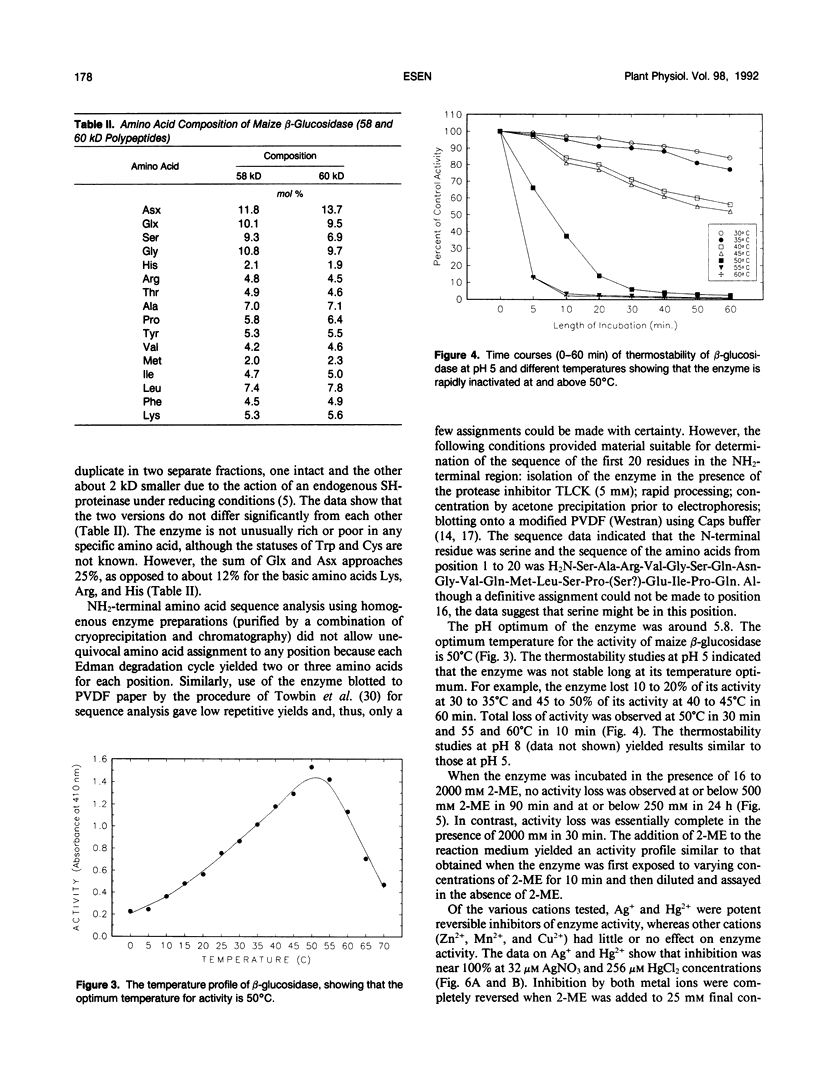
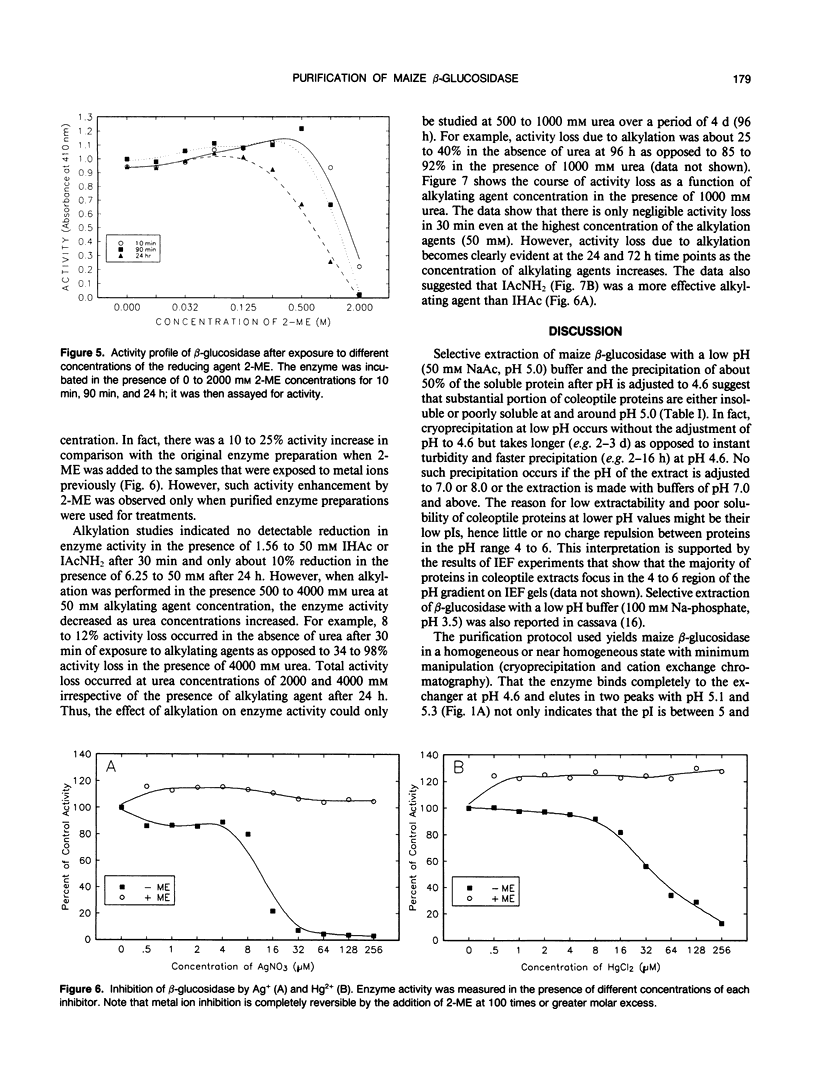
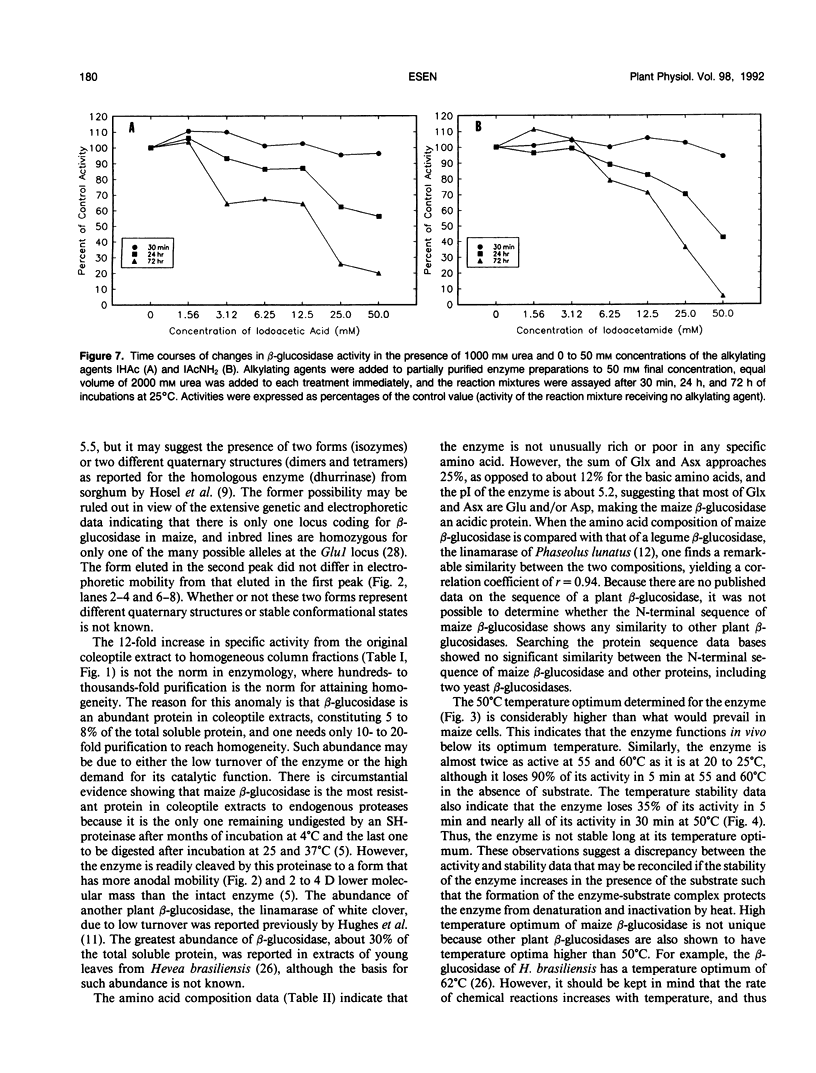

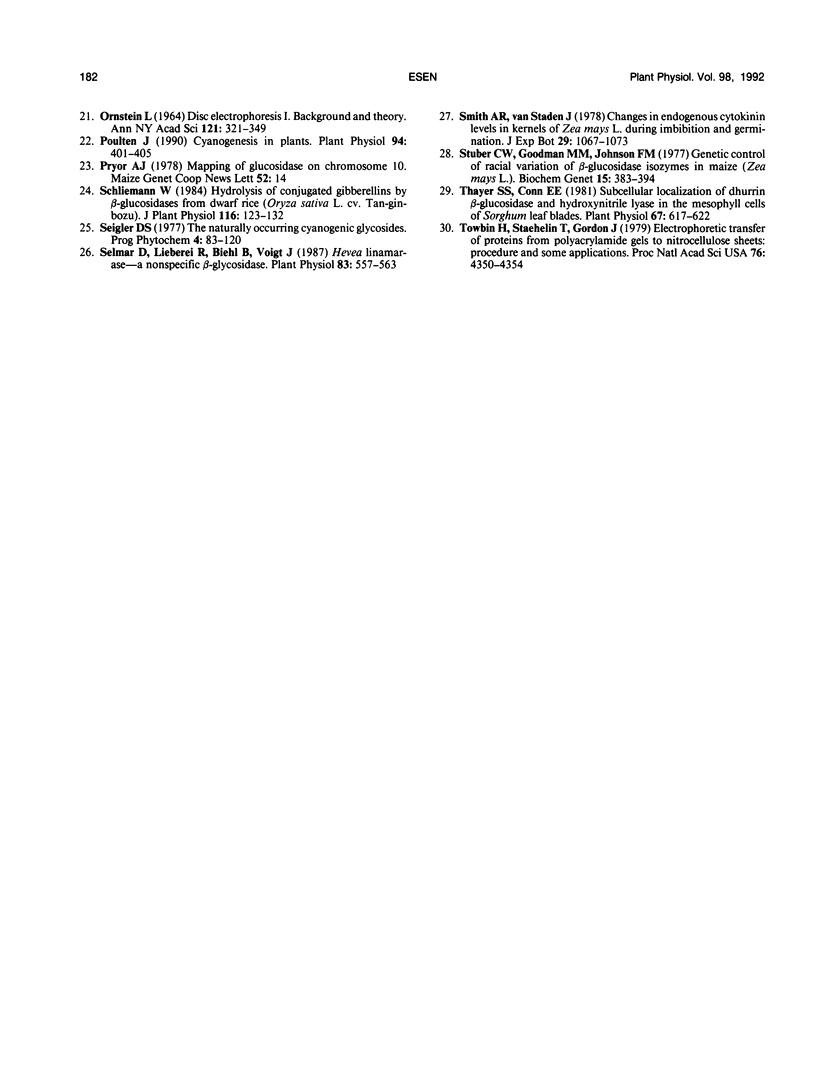
Images in this article
Selected References
These references are in PubMed. This may not be the complete list of references from this article.
- Bradford M. M. A rapid and sensitive method for the quantitation of microgram quantities of protein utilizing the principle of protein-dye binding. Anal Biochem. 1976 May 7;72:248–254. doi: 10.1006/abio.1976.9999. [DOI] [PubMed] [Google Scholar]
- DAVIS B. J. DISC ELECTROPHORESIS. II. METHOD AND APPLICATION TO HUMAN SERUM PROTEINS. Ann N Y Acad Sci. 1964 Dec 28;121:404–427. doi: 10.1111/j.1749-6632.1964.tb14213.x. [DOI] [PubMed] [Google Scholar]
- Esen A. A simple method for quantitative, semiquantitative, and qualitative assay of protein. Anal Biochem. 1978 Aug 15;89(1):264–273. doi: 10.1016/0003-2697(78)90749-2. [DOI] [PubMed] [Google Scholar]
- Esen A., Cokmus C. Maize genotypes classified as null at the glu locus have beta-glucosidase activity and immunoreactive protein. Biochem Genet. 1990 Aug;28(7-8):319–336. doi: 10.1007/BF02401422. [DOI] [PubMed] [Google Scholar]
- Hösel W., Tober I., Eklund S. H., Conn E. E. Characterization of beta-glucosidases with high specificity for the cyanogenic glucoside dhurrin in Sorghum bicolor (L.) moench seedlings. Arch Biochem Biophys. 1987 Jan;252(1):152–162. doi: 10.1016/0003-9861(87)90019-1. [DOI] [PubMed] [Google Scholar]
- Itoh-Nashida T., Hiraiwa M., Uda Y. Purification and properties of beta-D-glucosidase (linamarase) from the butter bean, Phaseolus lunatus. J Biochem. 1987 Apr;101(4):847–854. doi: 10.1093/oxfordjournals.jbchem.a121951. [DOI] [PubMed] [Google Scholar]
- Laemmli U. K. Cleavage of structural proteins during the assembly of the head of bacteriophage T4. Nature. 1970 Aug 15;227(5259):680–685. doi: 10.1038/227680a0. [DOI] [PubMed] [Google Scholar]
- Mkpong O. E., Yan H., Chism G., Sayre R. T. Purification, characterization, and localization of linamarase in cassava. Plant Physiol. 1990 May;93(1):176–181. doi: 10.1104/pp.93.1.176. [DOI] [PMC free article] [PubMed] [Google Scholar]
- Moos M., Jr, Nguyen N. Y., Liu T. Y. Reproducible high yield sequencing of proteins electrophoretically separated and transferred to an inert support. J Biol Chem. 1988 May 5;263(13):6005–6008. [PubMed] [Google Scholar]
- Nagahashi G., Baker A. F. beta-Glucosidase Activity in Corn Roots: Problems in Subcellular Fractionation. Plant Physiol. 1984 Dec;76(4):861–864. doi: 10.1104/pp.76.4.861. [DOI] [PMC free article] [PubMed] [Google Scholar]
- Nagahashi G., Tu S. I., Fleet G., Namgoong S. K. Inhibition of cell wall-associated enzymes in vitro and in vivo with sugar analogs. Plant Physiol. 1990 Feb;92(2):413–418. doi: 10.1104/pp.92.2.413. [DOI] [PMC free article] [PubMed] [Google Scholar]
- ORNSTEIN L. DISC ELECTROPHORESIS. I. BACKGROUND AND THEORY. Ann N Y Acad Sci. 1964 Dec 28;121:321–349. doi: 10.1111/j.1749-6632.1964.tb14207.x. [DOI] [PubMed] [Google Scholar]
- Poulton J. E. Cyanogenesis in plants. Plant Physiol. 1990 Oct;94(2):401–405. doi: 10.1104/pp.94.2.401. [DOI] [PMC free article] [PubMed] [Google Scholar]
- Selmar D., Lieberei R., Biehl B., Voigt J. Hevea Linamarase-A Nonspecific beta-Glycosidase. Plant Physiol. 1987 Mar;83(3):557–563. doi: 10.1104/pp.83.3.557. [DOI] [PMC free article] [PubMed] [Google Scholar]
- Stuber C. W., Goodman M. M., Johnson F. M. Genetic control and racial variation of beta-glucosidase isozymes in maize (Zea mays L.) Biochem Genet. 1977 Apr;15(3-4):383–394. doi: 10.1007/BF00484468. [DOI] [PubMed] [Google Scholar]
- Thayer S. S., Conn E. E. Subcellular Localization of Dhurrin beta-Glucosidase and Hydroxynitrile Lyase in the Mesophyll Cells of Sorghum Leaf Blades. Plant Physiol. 1981 Apr;67(4):617–622. doi: 10.1104/pp.67.4.617. [DOI] [PMC free article] [PubMed] [Google Scholar]
- Towbin H., Staehelin T., Gordon J. Electrophoretic transfer of proteins from polyacrylamide gels to nitrocellulose sheets: procedure and some applications. Proc Natl Acad Sci U S A. 1979 Sep;76(9):4350–4354. doi: 10.1073/pnas.76.9.4350. [DOI] [PMC free article] [PubMed] [Google Scholar]



